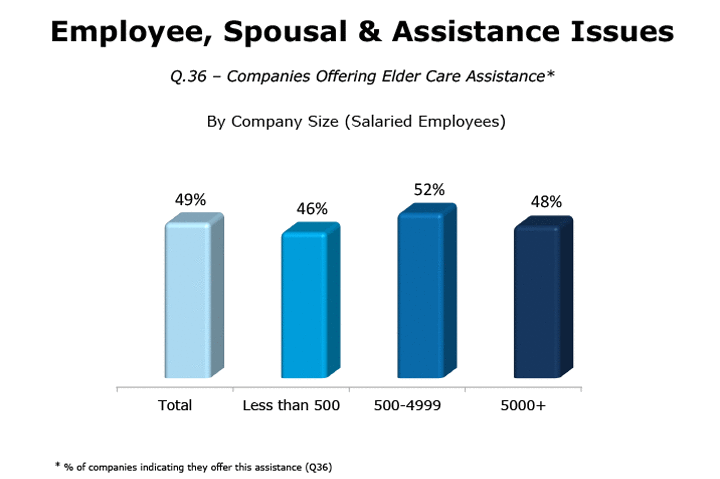Spousal Assistance
The seismic shift in spouse/partner employment that last year affected relocations almost always or frequently remains in place. Nearly two-thirds of firms saw this as an issue over the past two years, far more than at any time during the previous twelve years (62% and 63% vs. roughly half or less). While small firms have historically seen this around half the time, it ticks up again to 60% from 58% last year, which was slightly above average. The effect remains much more amplified among larger firms. An increase of more than 20 percentage points since 2013 remains in effect for mid-size firms (68% vs. 43%) after hitting 54% in 2014 and 65% in 2015. The impact among large firms is nearly double that of 2014 (61% vs. 32%) for the second year in a row.
With the importance of spouse/partner employment at far higher levels over the past two years compared to historical averages, far more firms continue to respond with offers of spouse/partner employment assistance. Firms of all sizes have offered this over the past two years far more than previously. However, for the first time this year, we see similar levels across company size, rather than as a likely perk among mid-size and large firms.
- The most popular form of employment assistance for all firms is networking assistance, with around a third offering resume preparation assistance. In the past, far more differences appeared in types of assistance by company size; this year levels are more consistent overall. The only marked differences: small firms are less likely than mid-size or large firms to offer payment for outplacement/career services from an outside firm (16% vs. 27% and 32%) and reimbursement of career transition expenses (16% vs. 25% and 31%).
- Small firms indicate that 27% of relocating employees with a spouse/partner used this type of assistance, while usage trends are around a third for mid-size and large firms.
Question 38
Frequency of employee's relocation being affected by employment status of spouse/partner

-- click to enlarge --
Question 39
Companies that allow the hiring of spouses of employees

-- click to enlarge --
Question 39a
Companies that assist an employee's spouse or partner in finding employment in the new location

-- click to enlarge --
Question 39b-1
Methods of spousal/partner employment assistance

-- click to enlarge --
Question 39b-2
Methods of spousal/partner employment assistance

-- click to enlarge --
Question 39c
Approximate percentage of relocated employees with a spouse/partner who used employment assistancee

-- click to enlarge --
International
Two-thirds of companies offer to help find jobs for spouses or partners relocating internationally, down from 77% in 2015, but remaining notably higher than in any previous year. From 2008 to 2014, levels of spousal assistance for international and domestic moves were nearly identical. They shifted last year as spouses/partners were more likely to be offered this assistance internationally (77% vs. 65% for domestic). The difference remains in 2016, to a slightly lesser degree (67% vs. 61%). Also, for the second year in a row, availability is similar across company size; historically, it has been more often associated with mid-size and large firms.
- Similar to domestic trends, the extension of different kinds of employment assistance is similar across company size, with two major differences. Mid-size firms seem most willing to find spouses/partners employment within their companies (35% vs. 15% for small firms and 18% for large firms). Mid-size firms appear to be more eager than large firms to look for employment outside the company (26% vs. 10%).
- Manufacturing/processing firms are twice as likely as for-profit service firms to pay for outplacement services for spouses/partners (23% vs. 12%).
Question 43k-1
Method of employment assistance for internationally relocated employee's spouse or partner

-- click to enlarge --
Question 43k-2
Method of employment assistance for internationally relocated employee's spouse or partner

-- click to enlarge --
Family Assistance
For the second year in a row, far greater accommodations are being made overall for childcare (62% vs. 31%-43%, historically) and elder care (49% vs. 16%-26%, historically), even if provisions are merely lists of possible centers and service providers for support. The impact of family issues/ties as a main factor in declined relocations may be impacted by the fact many employees in the mid-level and higher positions could be finding themselves caring for both older family members and children at the same time due to trends of later marriage/childbearing ages of higher educated/affluent members of the general population. These people tend to be in the highly educated pool employers tap for relocation. This can create a “sandwich” effect on employees in the prime years of their careers, squeezed by responsibilities for both job and family. While larger firms have typically offered family assistance more frequently than small firms, this year, akin to the trend for spouse/partner employment assistance, it is similar among firms of all sizes. The percentages offering assistance remain substantially above historical levels among firms of all sizes for the second year in a row.
Question 36-1
Companies offering elder care assistance

-- click to enlarge --
Question 36-2
Elder care assistance offered

-- click to enlarge --
Question 37-1
Companies offering childcare assistance

-- click to enlarge --
Question 37-2
Childcare assistance offered

-- click to enlarge --